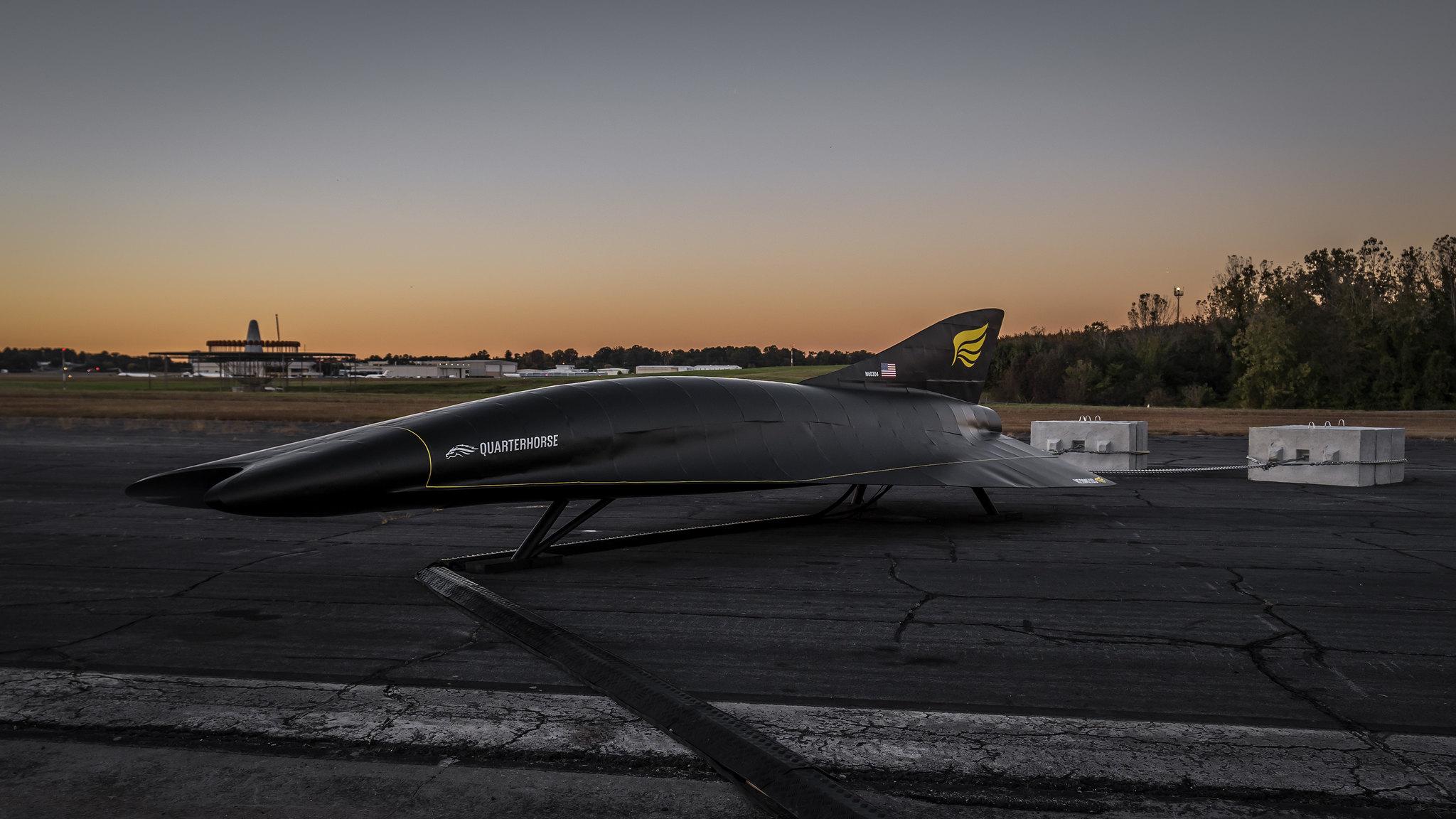
Start-up hypersonic aircraft developer Hermeus has unveiled a manufacturing prototype of the single-engine flight demonstrator it will test in advance of the development of a Mach 5 turbine-based combined cycle (TBCC) powered transport concept.
“We’ve framed it as less a mockup and more of a prototype,” Hermeus CEO A.J. Piplica said. “Internally the purpose of building it was to go through a full-scale manufacturing process and to get the team to build a full-scale aircraft. We’ve gained a lot of insight going through this process over the past four months, and we are rolling that back into the design of the vehicle for both manufacturing integration and operations.”
Dubbed the “Quarterhorse,” the single-engine structural prototype is just under 40 ft. in length and has a wingspan of almost 12 ft. Although the prototype is largely representative of the sharply swept Mach 5 demonstrator vehicle Hermeus plans to flight test in 2024, Piplica said “there’s obviously quite a bit of iteration still to come over the next few years, but it’s in the ballpark for what we expect to fly.”
Hermeus has meanwhile moved into its recently completed 5,000-ft.2 propulsion test facility near Atlanta, Georgia. There it will build the flight demonstrators as well as evaluate a larger, flight-scale version of its TBCC engine. Testing is intended to pave the way for the follow-on development of the first of three flight-test vehicles to be built under a $60 million U.S. Air Force contract awarded earlier this year under the U.S. Air Force’s recently launched Vector Initiative.
Supported by the AFWERX Strategic Funding Increase program led by the Presidential and Executive Airlift Directorate, the work is a follow-on to an earlier Phase II small business innovation research contract covering potential development of a high-Mach capable Air Force One transport. The collaboration also includes support from the Air Force Research Laboratory.
Each demonstrator vehicle will incorporate a General Electric J85-21 turbojet at the heart of the TBCC propulsion system. “We’ll be getting into ground testing within the next couple of weeks on the other side of the roll out,” Piplica said. “We’ll look to get that wrapped up early next year and then complete all of our high-speed testing by the end of the first quarter.”
Testing, which for this phase continues at the company’s original engine test site in DeKalb-Peachtree Airport, Georgia, will be focused on mode-transition work in a series of direct connect runs. For these tests, the flowpath will include all major components apart from the inward turning inlet. “We will connect to the front of the pre-cooler at the test facility, and then everything downstream—including the bypass system, turbojet, ram-burner and nozzle,” Piplica said. “The major goal is really demonstrating transition from the ramjet mode to turbojet mode and back. That’s the real key risk that we’re looking to reduce here.”
The mode-transition testing builds on initial subscale prototype tests in 2019-2020 that were based on a 290-lb. thrust, off-the-shelf TJ100 turbojet supplied by Czech-based high-speed turbine maker PBS. The combined cycle elements include Hermeus’s in-house developed pre-cooler and ramjet. The turbojet is designed to operate from a standing start to Mach 3.3, while the ramjet operates over the transition range from approximately Mach 2.8 to above Mach 3 and then onward to power the vehicle to Mach 5.
“We are also starting to build out our manufacturing capabilities in the new facility,” Piplica said. “By early next year we’ll be able to do a lot more in-house fabrication than we’ve been able to do so far, and we are starting to really build up that ability to vertically integrate the company. We can’t do it all up front but we are starting to get into [it] a lot faster than we maybe thought we were a year ago.
“All the design, analysis, integration and tests for the first prototype happened in-house with some of the fabrication, but for the most part we continue to leverage our network of suppliers that we’ve built over the past couple of years,” he added. “These are valuable partners across the board, both on the airframe side as well as the propulsion side and we expect that to continue going forward. However, I think when you look at the supply chain challenges that really everybody has seen, then being vertically integrated is incredibly important to really limit your exposure to those types of risks. We don’t necessarily see those going away anytime soon.”






Comments